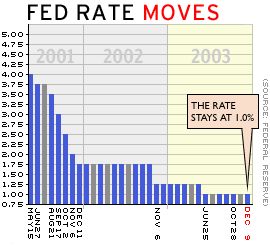NEW YORK (CNN/Money) -
Federal Reserve policy-makers upgraded their assessment of the U.S. economy Tuesday, but also kept language that signaled an interest-rate hike wouldn't come for a long time as they kept their key interest rate at a 41-year low.
Central bankers left the federal funds rate, an overnight bank lending rate that forms the basis for many banks' prime lending rates, at 1 percent, the lowest level since 1962.

In the closely watched statement accompanying the decision, the Fed also continued to say it would keep rates on hold for a "considerable period," contrary to the expectation of many Wall Street economists, who thought that language might change.
But the Fed also took note of some economic improvement, saying output was "expanding briskly" and that the "labor market appears to be improving modestly."
More important, they also stopped saying that the chance of a dangerous drop in inflation, which would hurt corporate profitability and economic growth, was their "predominant" concern.
"The probability of an unwelcome fall in inflation has diminished in recent months and now appears almost equal to that of a rise in inflation," the statement said. "However, with inflation quite low and resource use slack, the [policy-making] committee believes that policy accommodation can be maintained for a considerable period."
On Wall Street, stocks fell after the announcement, while Treasury bonds gave up early gains and also fell, as some investors bet the Fed's statements about inflation means the central bank is closer to raising rates.
"They've changed their risk assessment; that's a subtle shift, but it is a shift," said Kevin Logan, chief economist at Dresdner Kleinwort Wasserstein. "If you believe that inflation pressures will mount, they're closer to, rather than further from, a policy move."
Still, Logan thinks the Fed will probably hold rates steady through the first half of 2004.
And it could be telling that the Fed decided to hang on to the "considerable period" phrase, words some policy-makers reportedly don't like. With a majority of Wall Street economists predicting before Tuesday's meeting that the language would disappear, the Fed had a window for dumping it.
By keeping the language, the Fed may simply be running up a red flag that indicates rates will stay low, despite the recent economic improvement.
"I don't think this should alter anybody's views about the Fed in a major way," said Ethan Harris, chief economist at Lehman Brothers, who still thinks the Fed could stay on hold until January 2005, barring a dramatic shift in the economy.
"We've gone from a period where there was a reasonable chance the Fed might cut rates just four months ago to one in which the Fed is very much comfortably just sitting on hold for now," Harris said.
More jobs needed before next hike
The Fed, the nation's central bank, cuts the fed funds rate when it wants to spur economic growth, and boosts it to help ward off inflation.
In response to a recession, terrorist attacks, the three-year bear market in stocks, two wars, corporate scandals and other nightmares, the central bank's policy-makers have slashed the fed funds rate to 1 percent.
Despite a blistering 8.2-percent annualized economic growth rate in the third quarter and four straight months of growth in non-farm payrolls, most economists still doubted the Fed would raise the rate Tuesday -- especially after Friday's report from the Labor Department showed payrolls grew at a much slower pace in November than most analysts had expected.
The last time the Fed was in this position, during the "jobless recovery" that followed the 1990-91 recession, it waited until Feb. 4, 1994, to raise rates -- by which time payrolls outside the farm sector had grown by 4.2 million jobs from their bottom in May 1991.
This time around, non-farm payrolls bottomed out in July and have added just 328,000 jobs since, including the 57,000 in November. Meanwhile, factories are still using less than 75 percent of their production capacity -- some of the resource-utilization "slack" the Fed was talking about.
The weak job market has kept a lid on wage growth and helped sink core consumer price inflation to its lowest level since 1966.
Though there are plenty of signs of higher prices on the horizon -- the dollar's value has been sinking, while oil, gold and plenty of other commodity prices have been rising -- most economists believe the Fed won't raise short-term rates, at least until it's seen a few months of solid job growth and signs that inflation is about to hit consumers.
"They won't be spooked by stronger growth or declining unemployment, and they won't be spooked by increases in crude-materials prices," said former Fed Governor Lyle Gramley, now a consulting economist with Schwab Washington Research, who expects the Fed to stay on hold until late 2004. "They will wait until they see clear evidence that inflation is likely to turn up at the consumer level."

|

